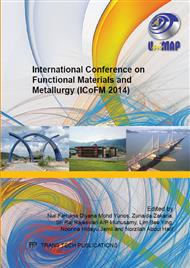[1]
M. Nehdi, J. Duquette and A. El Damatty. Performance of Rice Husk Ash Produced using a New Technology as a Mineral Admixture in Concrete. Cem. Concr. Res. 33(8) (2003), pp.1203-1210.
DOI: 10.1016/s0008-8846(03)00038-3
Google Scholar
[2]
P. Chindaprasirt, and S. Rukzon. Strength, Porosity and Corrosion Resistance of Ternary Blend Portland Cement, Rice Husk Ash and Fly Ash Mortar. Constr. Build. Mater. 22(8) (2008), pp.1601-1606.
DOI: 10.1016/j.conbuildmat.2007.06.010
Google Scholar
[3]
V. Saraswathy, and H.W. Song. Corrosion Performance of Rice Husk Ash Blended Concrete. Constr. Build. Mater. 21(8 ), (2007), pp.1779-1784.
DOI: 10.1016/j.conbuildmat.2006.05.037
Google Scholar
[4]
B.H. Abu Bakar, R. Putrajaya and H. Abdulaziz. Malaysian Rice Husk Ash–Improving the Durability and Corrosion Resistance of Concrete: Pre-review. Concr. Res. Lett. 1(1), (2010), pp.6-13.
Google Scholar
[5]
P. Chindaprasirt, S. Homwuttiwong and C. Jaturapitakkul. Strength and Water Permeability of Concrete Containing Palm Oil Fuel Ash and Rice Husk–Bark Ash. Constr. Build. Mater. 21(7), (2007), pp.1492-1499.
DOI: 10.1016/j.conbuildmat.2006.06.015
Google Scholar
[6]
G. R. de Sensale, B.A. Ribeiro and A. Gonçalves. Effects of RHA on Autogenous Shrinkage of Portland Cement Pastes. Cem. Concr. Compos. 30(10), (2008), pp.892-897.
DOI: 10.1016/j.cemconcomp.2008.06.014
Google Scholar
[7]
D.G. Nair, A. Fraaij, A. Klaassen and A. Kentgens. A Structural Investigation Relating to the Pozzolanic Activity of Rice Husk Ashes. Cem. Concr. Res. 38(6), (2008), pp.861-869.
DOI: 10.1016/j.cemconres.2007.10.004
Google Scholar
[8]
R.E. Rodrı́guez-Camacho and R. Uribe-Afif. Importance of using the Natural Pozzolans on Concrete Durability. Cem. Concr. Res. 32(12), (2002), pp.1851-1858.
DOI: 10.1016/s0008-8846(01)00714-1
Google Scholar
[9]
R. Zerbino, G. Giaccio and G.C. Isaia. Concrete Incorporating Rice-Husk Ash Without Processing. Constr. Build. Mater. 25(1), (2011), pp.371-378.
DOI: 10.1016/j.conbuildmat.2010.06.016
Google Scholar
[10]
M.F.M. Zain, M.N. Islam, F. Mahmud and M. Jamil. Production of Rice Husk Ash for Use in Concrete as a Supplementary Cementitious Material. Constr. Build. Mater. 25(2), (2011), pp.798-805.
DOI: 10.1016/j.conbuildmat.2010.07.003
Google Scholar
[11]
S.A. Memon, M.A. Shaikh and H. Akbar. Utilization of Rice Husk Ash as Viscosity Modifying Agent in Self Compacting Concrete. Constr. Build. Mater. 25(2), (2011), pp.1044-1048.
DOI: 10.1016/j.conbuildmat.2010.06.074
Google Scholar
[12]
M. Zhang and V.M. Malhotra. High-Performance Concrete Incorporating Rice Husk Ash as a Supplementary Cementing Material. J. ACI Mater. 93(6), (1996).
DOI: 10.14359/9870
Google Scholar
[13]
K. Ganesan, K. Rajagopal and K. Thangavel. Rice Husk Ash Blended Cement: Assessment of Optimal Level of Replacement for Strength and Permeability Properties of Concrete. Constr. Build. Mater. 22(8), (2008), pp.1675-1683.
DOI: 10.1016/j.conbuildmat.2007.06.011
Google Scholar
[14]
N. Ikram and M. Akhter. X-ray Diffraction Analysis of Silicon Prepared from Rice Husk Ash. J. Mater. Sci. 23(7), (1988), pp.2379-2381.
DOI: 10.1007/bf01111891
Google Scholar
[15]
F.J. Narciso-Romero and F. Rodriguez-Reinoso. Synthesis of SiC from Rice Husks Catalysed by Iron, Cobalt or Nickel. J. Mater. Sci. 31(3), (1996), pp.779-784.
DOI: 10.1007/bf00367899
Google Scholar
[16]
Pérez, J. M., Rincón, J. M., & Romero, M. Effect of Moulding Pressure on Microstructure and Technological Properties of Porcelain Stoneware. Cer. Int. 38(1), (2012), pp.317-325.
DOI: 10.1016/j.ceramint.2011.07.009
Google Scholar
[17]
Abadir, M. F., Sallam, E. H., & Bakr, I. M. Preparation of Porcelain Tiles from Egyptian Raw Materials. Cer. Int. 28(3), (2002), pp.303-310.
DOI: 10.1016/s0272-8842(01)00095-5
Google Scholar
[18]
H.U. Jamo, M.Z. Noh and Z.A. Ahmad. Influence of Temperature on the Substitution of Quartz by Rice Husk Ash (RHA) in Porcelain Composition. Appl. Mech. Mater. 465, (2014), pp.1297-1303.
DOI: 10.4028/www.scientific.net/amm.465-466.1297
Google Scholar


